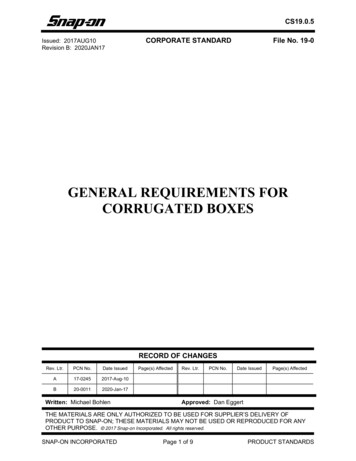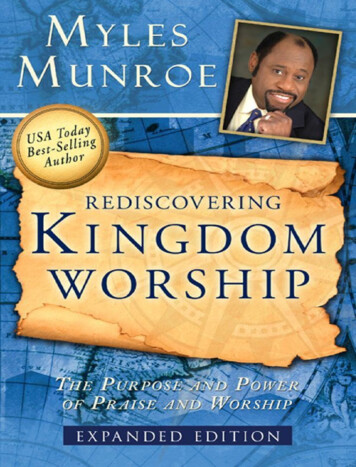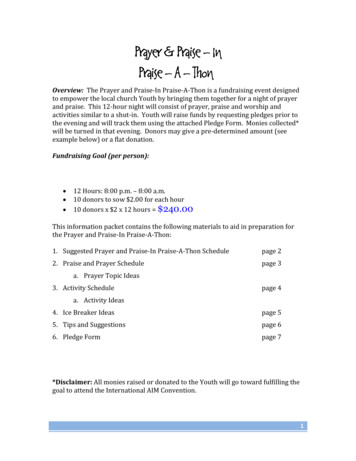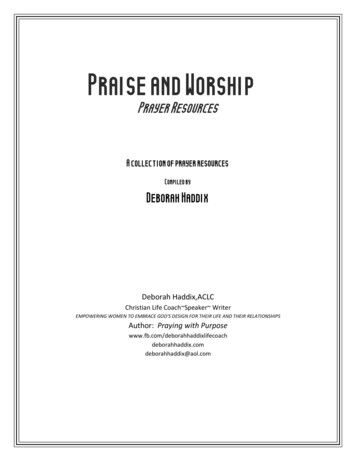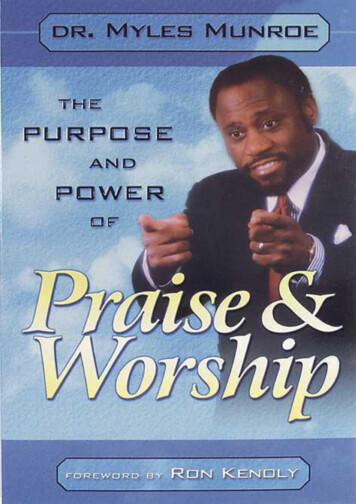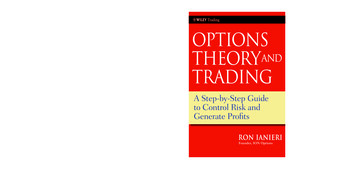
Transcription
(continued from front flap)Rounding out this detailed discussion of options is a close look at combination strategies.Part Four of Options Theory and Trading takes youthrough fully hedged strategies known as theButterfly and the Condor, and offers practical advice on how and when to use them.In an environment of increasing volatility, there’sgreat risk of market corrections endangering thecapital of individual investors around the world.What you need to achieve long-term success intoday’s market is the right guidance. With OptionsTheory and Trading, you’ll quickly discover how touse options to increase your portfolio’s profit potential and reduce the risks you’ll inevitably face.RON IANIERI is the cofounder and past chiefoptions strategist for Options University, andthe founder and Chief Options Strategist ofION Options, his new firm that provides courses,services, and training to aspiring options traders.Ianieri’s Option Theory and Trading Course isconsidered one of the best options training toolsin the industry. He has appeared on CNBC, CNN,and Fox Business News. Ianieri graduated fromSt. Joseph’s University in Philadelphia with adegree in finance.Praise forOptions Theoryand Trading“I’ve had the pleasure of teaching with Ron Ianieri at numerous live seminars fortraders and investors, and one thing is for sure—Ron knows options! Now Ronhas created a thorough, easy-to-read guide that you can benefit from in manyways, whether you are experienced in options trading or just starting out. I believe you will find Options Theory and Trading like Ron himself . . . full of knowledge,entertaining, fast-paced, and a joy to be around.”—Price Headley, CFA, CMT, founder of BigTrends.com“I’ve had the pleasure of knowing and working with Ron for many years now.When managing funds in our asset management company, Ron has always beenour ‘go-to guy’ on anything options-related. I’ve also taught a number of seminarsside by side with Ron over the years where I’ve always come home knowing moreabout options than when I left! The man is truly the ‘pitbull’ of derivatives.”—Peter Reznicek, Chief Equity Strategist, www.ShadowTrader.net“What a pleasure to read Ron Ianieri’s new book, Options Theory and Trading. As amarket technician for the last thirty-three years I am always looking for technicalmoves in stocks, and I rely on Ron’s expertise for the optimum options strategyneeded for each specific move I perceive happening in the markets. Ron’s ‘in thepits’ experience serves to correct the misinformation in much of the publishedmaterial and classes currently available to the unsuspecting options trader.”—David Steelsmith ElliottWallstreetteachers.com, World’s #1 Market Timer, USIC“Ron’s expertise in options is as high as there is and his experience is unparalleled. Ron not only knows the answer but can explain it in a ‘101’ fashion that issimple enough for even a novice to understand. His book is written in the samefashion. Ron not only explains the ‘how to’s’ but also the ‘how and why’ whichother books just don’t seem to do. As a day trader/swing trader by nature, I alsoappreciate Ron incorporating real chart examples for us directional traders. Forthese reasons, I would highly recommend Ron’s book to anyone interested inusing options.”—Chris Rowe, The Trend Rider, www.tycoonresearch.comIanieriOPTIONS THEORY and TRADINGWhile Ianieri demonstrates how well optionsfunction in unison with a stock position—enhancing potential gains, providing profitprotection, and limiting the risk of the entireinvestment—he also examines how they can beeven more effective when traded against eachother. In Part Three, you’ll gain an in-depth understanding of how to use vertical, diagonal, andtime spreads in this way, and discover how straddles and strangles—which both feature the useof options in unison with one other—can helpyou achieve strong premium collection. 75.00 USA/ 90.00 CANWOPTIONSandTHEORYTRADINGA Step-by-Step Guideto Control Risk andGenerate ProfitsRon IanieriFounder, ION Optionshen used correctly, options can greatlyenhance your profits. The leverage theyprovide allows small accounts to tradelike big ones, without the normally associatedrisks. And, in times of financial turmoil, optionscan keep you from incurring catastrophic losses.There are many ways in which options can bothprotect your portfolio and help you profit—but inorder to take advantage of these opportunities,you have to learn how to properly use options inyour investment endeavors.As the cofounder and former chief options strategist for the Options University, and now asfounder of ION Options, author Ron Ianieri is oneof the most well-respected, and well-informed,individuals in this field. Over the course of hissuccessful twenty-plus-year career in the optionsmarket, he has trained many professional traders, as well as numerous active investors. Now,with Options Theory and Trading, he shares hisextensive experience with you.Based on a proven option-trading course createdby Ianieri, which follows a logical step-by-stepprogression, this book opens with an in-depthexplanation of option terms and theory in PartOne—because learning the language and understanding the theory is the foundation uponwhich successful option strategies are built.Continuing along these lines, Ianieri takes thetime to explore the unique risks and rewards ofcall and put options, and introduces you to theoption pricing model, the “Greeks,” and syntheticpositions.In Part Two, Ianieri moves on to basic tradingstrategies involving stock and options, includingthe covered call/buy-write strategy, the coveredput/sell-write strategy, the protective put strategy, the synthetic put/protective call strategy,and lastly, the collar strategy. In addition to this,you’ll also discover the role of the “lean” in options trading and how to “roll” your position toestablish a stream of income.(continued on back flap)
P1: JYSFMJWBT098-DipietroMay 6, 200910:23viPrinter: Yet to come
P1: JYSfmJWBT099-IanieriMay 5, 200921:22Printer: Yet to comeOptions Theoryand TradingA Step-by-Step Guide to ControlRisk and Generate ProfitsRON IANIERIJohn Wiley & Sons, Inc.i
P1: JYSfmJWBT099-IanieriMay 5, 200921:22Printer: Yet to comeC 2009 by Ron Ianieri. All rights reserved.Copyright Published by John Wiley & Sons, Inc., Hoboken, New Jersey.Published simultaneously in Canada.No part of this publication may be reproduced, stored in a retrieval system, or transmitted inany form or by any means, electronic, mechanical, photocopying, recording, scanning, orotherwise, except as permitted under Section 107 or 108 of the 1976 United States CopyrightAct, without either the prior written permission of the Publisher, or authorization throughpayment of the appropriate per-copy fee to the Copyright Clearance Center, Inc., 222Rosewood Drive, Danvers, MA 01923, (978) 750-8400, fax (978) 646-8600, or on the web atwww.copyright.com. Requests to the Publisher for permission should be addressed to thePermissions Department, John Wiley & Sons, Inc., 111 River Street, Hoboken, NJ 07030, (201)748-6011, fax (201) 748-6008, or online at www.wiley.com/go/permissions.Limit of Liability/Disclaimer of Warranty: While the publisher and author have used their bestefforts in preparing this book, they make no representations or warranties with respect to theaccuracy or completeness of the contents of this book and specifically disclaim any impliedwarranties of merchantability or fitness for a particular purpose. No warranty may be createdor extended by sales representatives or written sales materials. The advice and strategiescontained herein may not be suitable for your situation. You should consult with aprofessional where appropriate. Neither the publisher nor author shall be liable for any loss ofprofit or any other commercial damages, including but not limited to special, incidental,consequential, or other damages.For general information on our other products and services or for technical support, pleasecontact our Customer Care Department within the United States at (800) 762-2974, outside theUnited States at (317) 572-3993 or fax (317) 572-4002.Wiley also publishes its books in a variety of electronic formats. Some content that appears inprint may not be available in electronic books. For more information about Wiley products,visit our web site at www.wiley.com.Library of Congress Cataloging-in-Publication DataIanieri, Ron, 1964–Options theory and trading : a step-by-step guide to control risk and generate profits /Ron Ianieri.p. cm. – (Wiley trading series)Includes index.ISBN 978-0-470-45578-4 (cloth)1. Stock options. 2. Portfolio management. 3. Risk management. 4. Options (Finance)I. Title.HG6042.I36 2009332.63 2283–dc222009004113Printed in the United States of America10987654321ii
P1: JYSfmJWBT099-IanieriMay 5, 200921:22Printer: Yet to comeTo my family and friendsiii
P1: JYSfmJWBT099-IanieriMay 5, 200921:22Printer: Yet to comeiv
P1: JYSfmJWBT099-IanieriMay 5, 200921:22Printer: Yet to comeContentsPrefacexiAcknowledgmentsxvPART IUnderstanding Terms and TheoryCHAPTER 1Options Basics and Terms13Calls and Puts4Classes and Series5In the Money, Out of the Money, and At the Money7Premium and Time Decay9Intrinsic versus Extrinsic Value9VolatilityCHAPTER 212Calls and Puts15Call Options15Put Options16CHAPTER 3Option Theory19Option Pricing Models20Fundamentals of Pricing Models21Types of Pricing Models25Inputs of the Options Pricing Model32Outputs of the Pricing Model39v
P1: JYSfmJWBT099-IanieriMay 5, 200921:22Printer: Yet to comeviCONTENTSCHAPTER 4Option Theory and the Greeks41Delta42Gamma52Vega57Theta68Second-Tier Greeks80CHAPTER 585Synthetic PositionsDefining Synthetics86Synthetic Stock88Synthetic Call96Synthetic Put106PART II117Basic StrategiesCHAPTER 6Introduction to Trading Strategies119Directional Trading Strategies119In-the-Money, Out-of-the-Money, and At-the-Money Options123Leverage and Risk128CHAPTER 7131Covered Call/Buy-Write StrategyFoundations of the Strategy131Performance in Different Scenarios135Lean138Rolling the Position139Examples141Covered Call/Buy-Write Synopsis146CHAPTER 8147The Covered Put/Sell-Write StrategyReviewing Selling Short147Foundations of the Strategy148Performance in Different Scenarios151Lean154Rolling the Position157
P1: JYSfmJWBT099-IanieriMay 5, 200921:22Printer: Yet to comeviiContentsExamples157Covered Put/Sell-Write Synopsis163CHAPTER 9165The Protective Put StrategyFoundations of the Strategy165Performance in Different Scenarios166Lean168When to Use the Protective Put Strategy170Examples172Protective Put Synopsis177CHAPTER 10 The Synthetic Put/ProtectiveCall Strategy179Foundations of the Strategy179Performance in Different Scenarios181Lean183When to Use the Protective Call Strategy184Examples187Synthetic Put Synopsis191CHAPTER 11 The Collar Strategy193Foundations of the Strategy193Performance in Different Scenarios194Lean197Examples199Collar Synopsis204PART IIIAdvanced Strategies: Spread Trading,Straddles, and Strangles207CHAPTER 12 Vertical Spreads209Construction of a Vertical Spread210Value and the Vertical Spread211Spread Prices Fluctuate217
P1: JYSfmJWBT099-IanieriMay 5, 200921:22Printer: Yet to comeviiiCONTENTSFactors that Affect Spread Pricing218Rolling the Position218Time Decay and Volatility Trading Opportunities220An Imaginary Spread Scenario222Recap with Special Insights224Examples225Bull Spread Synopsis230Bear Spread Synopsis231CHAPTER 13 Time Spreads233Construction of the Time Spread233Behavior of the Spread234Effects of Stock Price on the Time Spread236Effects of Volatility on the Time Spread237Buyer Risk and Reward244Seller Risk and Reward245Rolling the Position246Concluding Thoughts249Examples249Time Spread Synopsis253CHAPTER 14 The Stock Replacement/Covered CallStrategy (Diagonal Spread)255When to Use the Diagonal Spread257Rolling the Position259Conclusion259CHAPTER 15 Straddles261What Is a Straddle?261Straddle Scenarios262How It Works262Factors that Affect Straddle Prices263Risks and Rewards266Break-Even, Maximum Reward, and Maximum Risk267Conclusion271
P1: JYSfmJWBT099-IanieriMay 5, 200921:22Printer: Yet to comeixContentsExamples271Long Straddle Synopsis276Short Straddle Synopsis277CHAPTER 16 Strangles279What Is a Strangle?280Strangle Scenarios281How It Works281Factors that Affect Strangle Prices282Risks and Rewards285Break-Even, Maximum Reward, and Maximum Risk285Conclusion289Examples289Long Strangle Synopsis294Short Strangle Synopsis294PART IV297Combination StrategiesCHAPTER 17 The Butterfly299Constructing the Butterfly299Why Use Butterflies?301Butterfly and Synthetic Positions303What Will a Butterfly Cost?305Butterfly and the Greeks307Iron Butterfly309Long Iron Butterfly312Using the Butterfly312Long Butterfly Synopsis313Short Butterfly Synopsis314CHAPTER 18 The Condor315Long Condor315Short Condor316Why Use Condors?317How It Works320
P1: JYSfmJWBT099-IanieriMay 5, 200921:22Printer: Yet to comexCONTENTSCondors versus Butterflies321Condors and the Greeks323Iron Condors326How Do We Use Condors?330Long Condor Synopsis331Short Condor Synopsis332Conclusion335Appendix: Five Trading Sheets337About the Author343Index345
P1: JYSfmJWBT099-IanieriMay 5, 200921:22Printer: Yet to comePrefacever the last several years, more and more investors have taken onthe responsibility of managing their own investments and retirement accounts. The numbers of those doing so is steadily increasingfor a variety of reasons. Investing your own money is not an impossible taskbut requires a conscious commitment to that endeavor. Private investorscan make profitable investment decisions if they are willing to dedicate thetime and effort necessary to learn how to invest wisely.Options Theory and Trading is designed to help you, as an investor,take a more proactive approach to managing your money and controllingyour financial future. Its aim is to help you learn how to use options toprotect your portfolio, manage risk, and enhance returns. Keep in mindthat no one cares more about your money than you do. So it makes sensethat you, more than anyone else, should know where your money is andhow it is performing.As diligent investors, we rely on research, analysis, and experience toturn the odds in our favor. Having access to the right information is often the key factor to an investor’s long-term success in the market. Tobe successful in any endeavor, you must know what to do, and how andwhen to do it.My goal in Options Theory and Trading is to give you the key information needed to excel in the financial markets. I will discuss the ins andouts of options, and how they can significantly improve your returns anddramatically reduce risk. My job is to educate you in the field of option investing just as I have educated many professional traders and active privateinvestors.Options, when used smartly and correctly, can greatly enhance yourprofits. The leverage in options, again when used correctly, can help smallaccounts trade like big accounts without the normally associated risks.And in times of financial turmoil, when the markets are constantly trading down, options can keep you from catastrophic losses. Options are lifeinsurance policies for your portfolio and, when used in a judicious manner,can be an investor’s best friend.Oxi
P1: JYSfmJWBT099-IanierixiiMay 5, 200921:22Printer: Yet to comePREFACEUsed appropriately, options can serve as valuable additions to an investor’s arsenal of effective investment and hedging vehicles. A proper understanding of option strategies will completely change how you invest.That understanding will show you how to increase profits and reduce riskwhile limiting the amount of capital you put at stake.As we move forward into a future where world economies are becoming more and more globalized, we are finding that the effects of oneeconomy directly affect all. This results in an environment of increasingvolatility in the financial markets and a greater risk of market corrections endangering the savings of individual investors around the world. Investors’ only hope for stabilizing the growth of their investments may welldepend on their acceptance and use of options.Over the course of my 20-plus years in the options market, I have readmany books on options. Some have been general but oversimplified; others have been very specific but too technical. During those years, I havealso trained many professional traders and, recently, many individual investors. I learned many valuable lessons about how people learn and howinstructors teach. From those experiences, I have made some interestingobservations concerning education in the field of options.One observation is that many option instructors—by far the large majority I have encountered—have trouble being easy to understand and stillcompletely thorough in the depth of their teachings. Easy to understandshould not mean that important but difficult topics are omitted. It doesmean that those difficult topics must be broken down into understandablepieces. That is what will happen in this book.Another observation is that options are constantly taught backward.Option theory is taught last as an “advanced topic” while the strategiesbased on that theory are taught first. These topics should be taught theother way around. Logically, option theory should be, and needs to be, firstin instruction . . . before the strategies. Option theory is the foundation onwhich strategies should be built. Those who do not understand the theory first never fully understand options. If you do not fully understand options, then you cannot truly understand the strategies based on options.And those who do not understand their positions in all market situationsare not around for too long.The topics of option theory are the cornerstones, the foundations ofunderstanding an option. Having investors truly understand options andtheir uses is my goal. When investors understand options, they are ableto select the optimal strategy on a consistent basis and to construct thatstrategy in the most cost-efficient way. Understanding options helps whenthings do not go the way you thought they would. Remember, we all havelosing trades from time to time. Understanding options allows you to bein a position to cut losses quickly. Understanding will let you know where
P1: JYSfmJWBT099-IanieriPrefaceMay 5, 200921:22Printer: Yet to comexiiiyour risks are before you put on the trade and will give you the tools tocounter those risks.Options are a more sophisticated product than their underlying instruments, such as stocks. As they are more sophisticated, there are many moretopics and concepts to master in order to use their power properly. Withoptions, as with any other highly technical vehicle, a solid foundation is thekey to understanding.The ability to truly understand the options you are trading is critical toconsistent profitability in all markets: up, down, and sideways. So, when Idesigned my option trading course for the professional floor trader, I builtit in a way that forced students to learn in a logical step-by-step way. Individual investors also can use this method to understand options.In this book, I present basic option theory and strategy in the samemanner and specifically following the same order that I use in my optionsclasses to retail and professional traders, As you move through the book, alogical progression of topics will become evident. This logical progressionwill enable you to learn in a way that leads to a quicker understandingof options and, in turn, quicker understanding in your option use. I knowmany people who trade options. Some win, but many lose. Those who trulyunderstand options are those who win, making money consistently andwith less risk.Having said all that, let me add a caveat. Understand that just readingthis one book will not make you an expert. Just as you cannot read onebook on golf and expect to be in a class with Tiger Woods or any pro, reading my book is by no means the end of your learning process. In fact, it ismy hope that this is just the beginning of your option education. OptionsTheory and Trading should provide a strong foundation for your understanding of options. But you will need to read more, take classes, practicepaper trading, and continue your education; in other words, you must takethe steps necessary to be proficient not just in understanding options butin using them to safeguard your financial future.
P1: JYSfmJWBT099-IanieriMay 5, 200921:22Printer: Yet to comexiv
P1: JYSfmJWBT099-IanieriMay 5, 200921:22Printer: Yet to comeAcknowledgmentso Think or Swim (www.thinkorswim.com), for allowing me to usetheir charts and graphs to illustrate this book.To my friend John Person of nationalfutures.com, for the inspiration and gentle kick in the butt I needed to get this book started.To John Wiley & Sons, especially Meg Freeborn and Kevin Commins, who made my next-to-impossible transition from trader to author assmooth as possible, considering who they had to work with: me. One bookdown, two more to go. Thanks, guys.To my partner and friend Brett Fogle, in appreciation for the tirelesshours of work and personal sacrifices it took to make the dream a reality.To my parents, in appreciation of the love, support, and encouragement they have given me not only through this process but through lifeitself . . . not to mention the tireless hours of editing and proofing. Thanks,Mom and Dad.To my son Christopher, who sacrificed potential quality time with hisdad during the time it mattered most without a whimper or complaint. Icould never ask for a better son than you. I am proud and honored to beyour father.Finally, and most especially, to my wife, Sherry, whose undying andunwavering love, loyalty, devotion, and friendship made this book and everything else that’s good in my life possible. When no one else believed inme, you did. You deserve much better than me. I hope to live up to all youdeserve in a husband and a friend.Txv
P1: JYSfmJWBT099-IanieriMay 5, 200921:22Printer: Yet to comexvi
P1: OTAc01JWBT099-IanieriMay 5, 200921:27Printer: Yet to comePART IUnderstandingTerms and Theorys with any field of study, an understanding of the vocabulary andspecial terms used is essential. Options use a special language. Specific terms that you should master are noted in italics. Learning thelanguage of options is the first step in learning how to use them.Continuing the development of our foundation toward option understanding, we devote time to the study of the two types of options, the calland the put, and their unique risk/rewards for the investor.From there, we move on to option theory with special emphasis on thepricing model, the Greeks, and synthetic positions.The pricing model gives you an overview of those components thatcontribute to the price of options; the Greeks provide the tools necessaryto manage risk; and the synthetic positions set the groundwork for the versatility of option use.A1
P1: OTAc01JWBT099-IanieriMay 5, 200921:27Printer: Yet to come2
P1: OTAc01JWBT099-IanieriMay 5, 200921:27Printer: Yet to comeCHAPTER 1Options Basicsand Termsn option is a traded security that is a derivative product, a product whose value is based on or derived from the price of somethingelse. A stock option is based on, among other things, the price ofthe underlying stock. Options also exist on other traded securities, such ascurrencies, commodities, bonds, indexes, and interest rates.A distinguishing factor of an option is that it is a depreciating asset;that is, it has a limited life. It has to be used before the date on which itexpires. As time goes by, the option loses value as it moves closer to itsexpiration date.When we speak of options in terms of volume, we refer to contracts.Each stock option contract is equivalent to 100 shares of stock. When wetalk about two contracts, we are talking about 200 shares; 10 contracts,1,000 shares; 75 contracts, 7,500 shares; and so on.It is important to understand the dollar cost of options before actuallytrading them. When an option is quoted at 1.00 per contract, the investormust realize that the 1.00 represents a price of 1.00 per share, not percontract. Remember that each contract represents 100 shares. This meansthat if you buy one option contract at a quoted price of 1.00, your totalcost would be 100.00 (1 contract 1.00 per share 100 shares per contract). If you buy 10 contracts for 1.00 per contract, your total cost will be 1,000.00. Use the following formula when calculating total dollar cost ofthe option, and review Table 1.1.ATotal Dollar Cost of Trade Number of Contracts Price per Contract 1003
P1: OTAc01JWBT099-IanieriMay 5, 200921:274Printer: Yet to comeUNDERSTANDING TERMS AND THEORYTABLE 1.1 Option Dollar Costs ( 1.00 Quoted Price of Option)Number ofContracts1510 Price perContract 1.00 1.00 1.00 100 (Sharesper Contract)1005001000 Dollar Costof Trade 100.00 500.00 1,000.00Option contracts are literally a sales agreement between two parties.The two parties are the buyer (or holder) and the seller (or writer). Whenyou buy an option contract, you are considered long the option. Whenyou sell an option contract, you are considered short the option. This, ofcourse, is assuming you have no previous position in that option.In an option contract, although it seems as if the buyer and seller mustbe tied together, they are not. You see, the buyer doesn’t really buy fromthe seller and the seller doesn’t really sell to the buyer. In reality, an organization called the Options Clearing Corporation (OCC) steps in betweenthe two sides. The OCC buys from the seller and sells to the buyer. Thismakes the OCC neutral, and it allows both the buyer and the seller to tradeout of a position without involving the other party.CALLS AND PUTSThere are two types of options, a call option and a put option.1. A call option gives the buyer the right, but not the obligation, to buya specific security at a specific price by a specific date. It is a way oflocking in the purchase price of the stock for a period of time.2. A put option gives the buyer the right, but not the obligation, to sella specific security at a specific price by a specific date. It is a way oflocking in the sales price of a stock for a period of time.The specific date is known as the contract’s expiration date. On orprior to the expiration date, the holder of the option contract has the rightto exercise the option; that is, the option holder can trade out of the position at any time up to expiration in the open market.The term exercise stands for the process by which the buyer of an option converts the option to a long stock position in the case of a call or ashort stock position in the case of a put. Buyers of options exercise.
P1: OTAc01JWBT099-IanieriMay 5, 200921:27Options Basics and TermsPrinter: Yet to come5The term assign or assignment refers to the process by which theseller of an option is notified of the buyer’s intention to exercise.The strike price or exercise price is the price at which the holder hasthe right, but not the obligation, to buy (for a call) or sell (for a put), theunderlying security. Strike prices are quoted in dollars; for example, May50 calls means May 50.00 strike calls.A long position is defined as any position that theoretically will increase in value, should the price of the underlying security increase. Likewise, the position theoretically will decrease in value, should the underlying security decrease. The buying of stock, the buying of a call, or thesale of a put all constitute establishment of long positions since they allrepresent ways that will benefit the position owner from an increasingstock priceA short position is defined as any position that theoretically will increase in value, should the price of the underlying security decrease. Similarly, the position theoretically will decrease in value, should the underlying security increase. The selling of stock, the selling of a call, or the buyingof a put establishes a short position where all will benefit from a decreasein the underlying stock price.CLASSES AND SERIESThe option class identifies the specific underlying security the option iswritten on. The option series describes the expiration month and strikeprice. As an example, let’s use the Microsoft (MSFT) May 65 calls. MSFTis the option class (identifies the security). May 65 call is the option series.May is the expiration month, and 65 is the strike price. All segments of thisoption are represented by symbols. The underlying stock, month, and pricehave a special code.All stocks and options are identified by symbols. Each stock has a specific symbol. For example, stock symbol HD Home Depot, while MSFT Microsoft. Options have symbols too. These symbols are standardized forall exchange-traded (listed) options. Most stock symbols match their tickersymbol. For options of the New York Stock Exchange (NYSE) and American Stock Exchange (AMEX), the option’s symbol is always the same asthe ticker symbol. The exceptions are the stocks of the NASDAQ. The stocksymbol for NASDAQ stocks consists of four letters. Option-class symbolsare limited to three letters. Symbols for NASDAQ-traded options are closeto the ticket symbol but include the letter Q (to signal NASDAQ). For example, consider the computer maker Dell; its ticker symbol is DELL and
P1: OTAc01JWBT099-IanieriMay 5, 200921:27Printer: Yet to come6UNDERSTANDING TERMS AND THEORYTABLE 1.2 Month berNovemberDecemberits option symbol is DLQ. The ticker symbol for Intel is INTC and its optionsymbol is INQ.Another exception for the ticker symbol use is with LEAPS. Options indifferent years receive different class symbols to overcome the limitationof the expiration month symbol, which does not take into account the samemonth existing in differe
traders and investors, and one thing is for sure—Ron knows options! Now Ron has created a thorough, easy-to-read guide that you can benefi t from in many ways, whether you are experienced in options trading or just starting out. I be-lieve you will fi nd Options Theory and Trading like Ron himself . . . full of knowledge,


